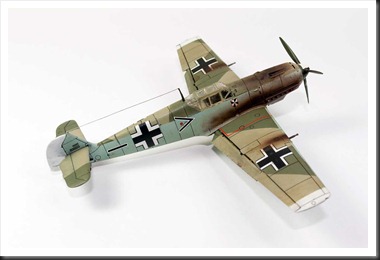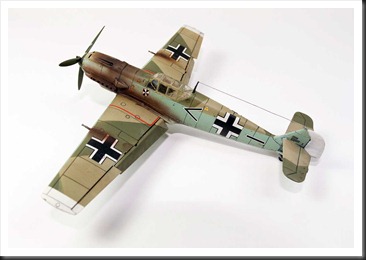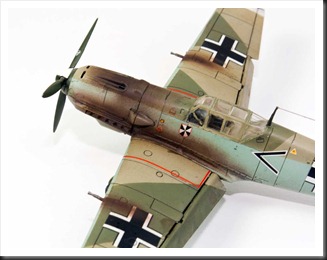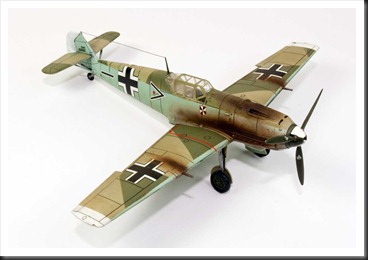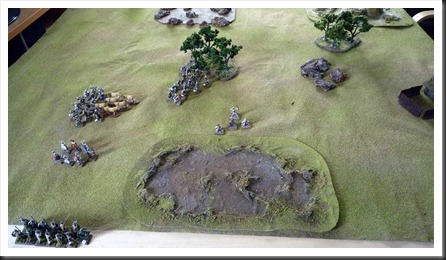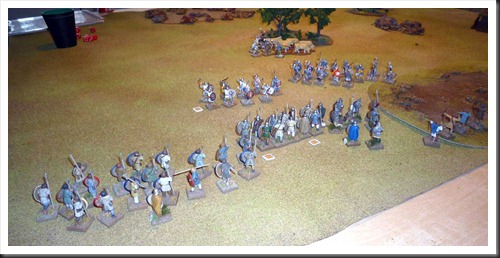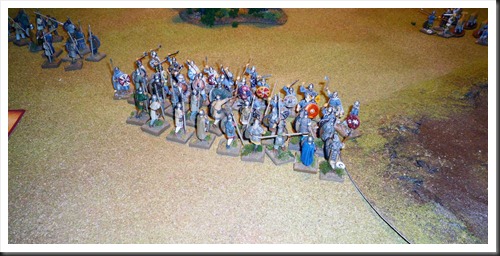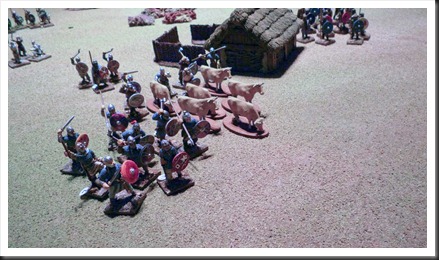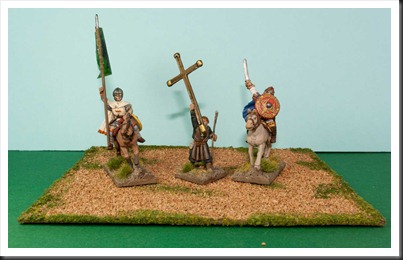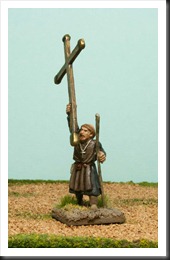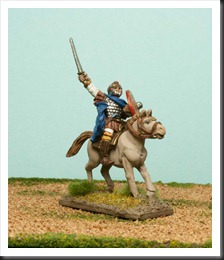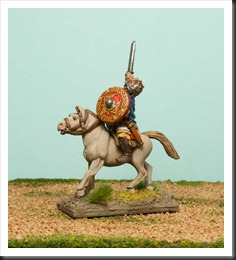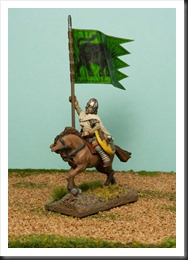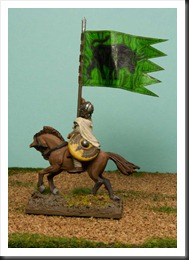Sorry guys, unfortunately this is not another after-action report, but a rather lengthy rant about the ruleset itself and why, in my humble opinion, it is not The Holy Grail of Napoleonic period rulesets.
The good…
In many respects, General de Brigade is an excellent ruleset, especially if you like a strong whiff of traditional approach to game mechanics. There really isn’t anything surprising or revolutionary in it, as the turn sequence clearly indicates – initiative roll decides who is the ‘phasing’ player (i.e. has precedence in certain phases of the turn), followed by compulsory movement (routes, pursuits and such), attempts to change brigade orders, charge declarations/moves, normal movement, firing, melee and finally morale checks where necessary. Once done, rewind and repeat until a conclusion is reached.
Traditional thinking expresses itself in other ways. Both firing and melees are accomplished with 2D6 dice rolls subsequently being adjusted by a bunch of modifiers. Final outcomes are looked up on tables providing the casualty numbers alternatively results of the melee. While there is nothing innovative in this approach, I do like it (well, to a degree, see below) mainly because it allows for an approximate estimation of casualty rates. This in turn allows the player to actually plan his assault and defence and allocate forces necessary for accomplishment of a specific task.
Charges are a bit fiddly, but on the other hand I am yet to encounter a ruleset that handles this aspect of the battle in a smooth way. On the positive side, anyone familiar with Napoleonic period will understand why charge procedure works the way it does in GdeB.
GdeB’s handling of skirmishers needs to get an honorary mention. Rules governing this troop class are very simple and yet, they manage to reflect perfectly role of skirmishers during that period. What’s perhaps even more important, those simple rules also manage to reflect differences in skirmish doctrine of different nationalities in a way that actually has real impact on the ‘battlefield’.
the bad…
In my opinion, most rulesets can be described as either ‘historical’ or ‘gamey’. I’m sure other wargamers have different definitions for those words. For me, a ‘historical’ ruleset can be recognized by its more or less uncompromised adherence to history, even if it influences the game experience in negative way. ‘Harpoon’ is a perfect example of such a ruleset. A ‘gamey’ ruleset focuses on the other hand foremost on the game experience. History component in such rulesets is used to provide the flavour, but isn’t much of a speed-bump when creator’s ‘artistic freedom’ needs to flex its muscles (dare I use ‘Flames of War’ as an example for that type of ruleset?).
General de Brigade is a strange mix of those two styles. In some respects (order system, command&control, restrictions of brigade system, charge mechanism) it is obvious that author tried very hard to transfer the reality of Napoleonic period battlefield onto the tabletop. But at the same time, other aspects of the ruleset are surprisingly ‘gamey’.
The most evident example of ‘gamey’ approach is without a doubt the ‘Dispersal Point’. In it's entirety, this game mechanism is a fair bit more complex, but it essentially means that units that have suffered 50%+ casualties are to be automatically removed from the battlefield. Let’s disregard the historical implications of that rule, although it is quite amusing to wonder over how Napoleon would react if one of his marshals told him ‘Sir, this or that battalion has now lost half its strength, so it will be leaving the battle line now, if you don’t mind.’. My main objection to this approach to unit breaking due to excessive casualties is directed against its deterministic character and how it influences the players during the ‘battle’. If I know that a unit will literally disappear when it reaches a predetermined ratio of casualties, I will play in a way that will achieve that goal. That’s where ‘gamey’ factor enters the picture in my opinion. Real commanders didn’t think in such way, simply because there is no nicely predetermined “breakage point” on a real battlefield.
Same gamey approach can also be found in rules for melee, where number of casualties is predetermined by number and unit type of participants. A player can therefore calculate in advance exactly how big his casualties will be in any melee. Considering the chaotic nature of melee, that is a very generous approach to this aspect of the game.
My problem with both of those mechanisms is, as already indicated, caused by the blanket of certainty they provide to the players. I will therefore try to ‘muddle the water’ a bit in coming games with couple of house rules. In regard of melee casualty rates, I’m toying with the idea of opposing die rolls that will modify those neatly predetermined numbers. For example, the ruleset says that in a basic infantry melee the winning side inflicts 1 casualty per 6 figures, while losers inflict 1 casualty per 12 figures. An opposed die roll with D4 could then be applied to casualty rates of both sides, thus providing a spread of -3 to 3 random modifier to the butcher’s bill. Elite troops could roll with D6 dice, giving them additional punch in shock combat.
Dealing with ‘dispersion point’ is a bit more difficult and I still haven’t come up with a house rule that I like. To be fair, it has to be said that individual battalions are quite resilient in GdeB and automatic removal of units with 50%+ casualties certainly does speed up the game. But as I mentioned before, the deterministic character of this rule really bothers me and I will have to do something about it.
and the ‘meeh’
If there is a single section of the ruleset that I really don’t like, then it’s the rules that govern the risk to general officers. Basically, they are toothless. Possibility of something bad happening to a commanding officer is triggered by a result of double sixes in any dice roll used for resolution of fire or melee. Thus, statistically, a chance for a bad thing happening is 1 in 36, a very low probability indeed. Another roll with two D6 is then required to determine nature of the event. What I don’t understand is why, considering the already low probability of ‘bad things’ happening to officers, about 30% of results on effect table has no effect whatsoever!
Another issue that I have with this mechanism is in its inability to deal with high risk decision of placing commanding officers in front of the troops. Leading from the front has always been regarded as noble and brave… and for a very good and rather obvious reason! Not so in ‘General de Brigade’ though. Letting brigade commanders to lead troops charging into a melee is in my opinion a no-brainer, simply because additional bonus in charge morale checks heavily outweighs possibility of them ‘buying the farm’ due to a random double six. Just to illustrate the inadequacy of this method, I’d like to remind the reader of a situation in my game where a French battalion suffered 10 out of 26 figures in casualties during a single melee. That’s more than one soldier in three. Needless to say, the brigade commander who led them from the front didn’t even get a scratch during that engagement.
Final thoughts
Let me be clear on one point - don’t let my critique give you the impression that General de Brigade is a bad ruleset. My opinion is in fact quite opposite – it is apparent that a lot of thought was dedicated to it being able to realistically recreate a Napoleonic battle at battalion/brigade level. However, there are in my opinion certain aspects in this ruleset that are ‘compromised’ for the sake of the gameplay. Some may live with it, others will feel the need to ‘correct’ this or that aspect of the game. After all, that’s the beauty and the curse of our hobby – no ruleset survives the first contact with a gamer.
